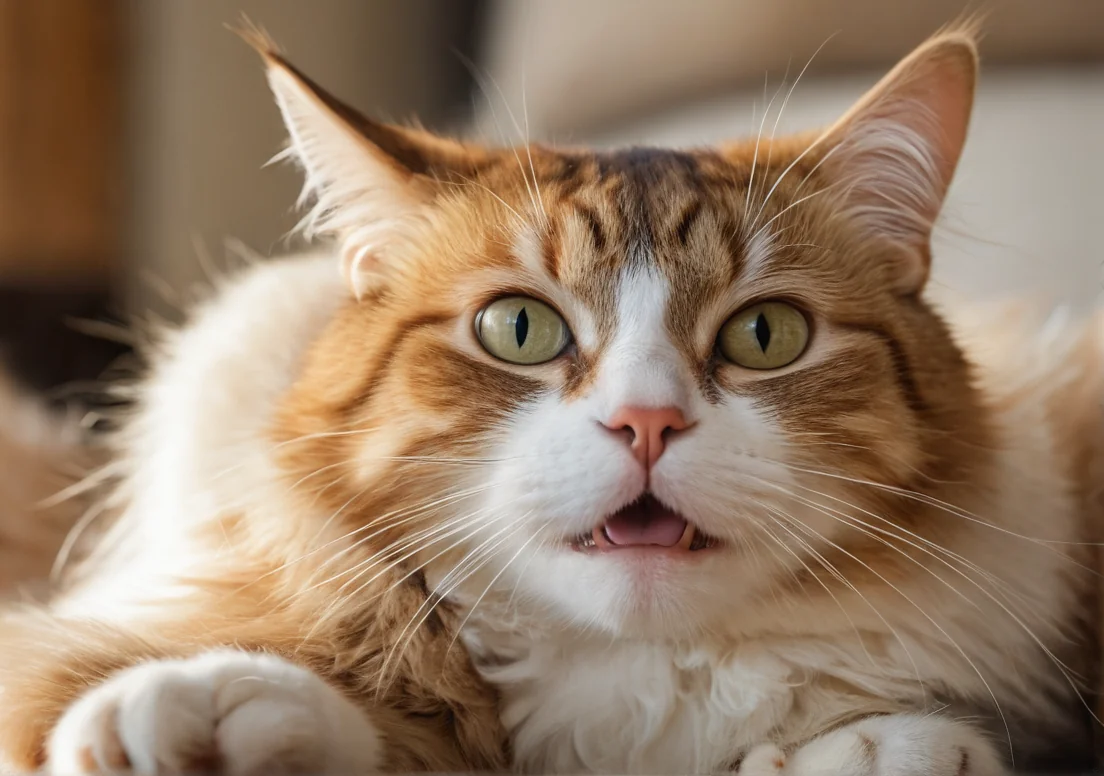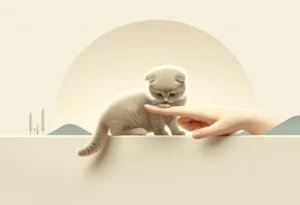Ever noticed that cozy moment when your cat purrs, and right out of the blue, they nip at your fingers? It’s puzzling, even a bit alarming, but it happens. You’re not alone in this feline mystery!
Cats often bite while purring as a form of play, affection, or overstimulation. It’s their way of communicating excitement or need for personal space. But there’s a fascinating range of reasons behind this behavior that can help you build a better bond with your furry friend. Keep reading to unlock the secrets of your cat’s quirky antics!

Why do cats purr?
Purring is one of the most recognizable sounds associated with cats, and it carries a variety of meanings. Contentment is often the first thing that comes to mind—when your cat is curled up in your lap, purring softly, there’s a good chance they’re feeling safe and happy. But purring isn’t just about comfort. Cats also use it to communicate their needs or emotions. For instance, they may purr when they’re frightened or stressed, as it can have a soothing effect on themselves and signal distress to others.
Moreover, purring isn’t solely an expression of pleasure. It can also play a role in self-healing. Research shows that the vibrations produced during purring, ranging from 25 to 150 Hertz, can promote the healing of bones and tissues. This adaptation may have evolved to help cats recover from injuries or stress more efficiently. So, if you notice your cat purring while also nipping at you, it might be trying to self-soothe even as it feels a bit overwhelmed.
You might also observe that cats sometimes purr while eating or during other activities. This suggests that their purring repertoire serves various purposes, including strengthening social bonds with their humans or other animals. In many ways, a cat’s purring is a complex behavior that speaks to their multifaceted nature, encompassing comfort, communication, and even healing.
What triggers the biting reflex?
Biting can seem puzzling, especially when your feline friend is purring. It usually stems from a few main triggers, and understanding these can help clarify their behavior.
Play Aggression : Cats are natural hunters. When they pounce and wrestle with you, it may seem like innocent fun, but they might be channeling their instinctual hunting behavior. They could get overstimulated and switch from gentle nibbles to bites.
Overstimulation : Cats can only take so much petting before they start to feel overwhelmed. Signs include tail twitching or ears flattening; if you miss these cues, they might bite to indicate they need a break.
Fear or Defense : If a cat feels threatened or cornered, it may bite as a defense mechanism. Even if you’re petting them, a sudden loud noise can trigger that instinctive reaction.
Communication : Biting can also serve as a way for your cat to communicate its boundaries or desires. Sometimes, they’ll use a gentle nip to get your attention or let you know they’ve had enough affection.
Redirected Aggression : If your cat sees another animal outside or hears something that excites them, it may redirect that aggression towards you instead, resulting in a sudden bite.
Recognizing these triggers can help you avoid those surprising nips. To foster a better understanding, consider incorporating toys for play, pay attention to their body language, and take breaks to prevent overstimulation. When playtime gets a bit too intense, swapping in a feather toy or laser pointer can channel their energy into something more appropriate.
Is my cat just playing?
Feline behavior can be puzzling, especially when it includes a purring cat who bites. Often, these bites occur during moments of play, reflecting a cat’s natural hunting instincts. Cats are instinctual hunters, and purring signifies not only relaxation but also that a cat may be in a playful mood.
When your cat is playfully biting, it usually means they’re engaging with you in a light-hearted manner. They might be mimicking the excitement of a hunt, suggesting they see you as a playmate. Signs to look for during these playful interactions include:
- Tail position: A swishing tail can show excitement.
- Body language: A relaxed stance often accompanies playful biting.
- Paw movement: Pouncing or batting at your hand shows interest.
Keep an eye on your cat’s overall demeanor. If they seem relaxed, it’s likely they’re just playing. If the biting becomes too forceful or aggressive, gently redirect their attention with a toy or treat.
Could it be affection?
Love bites—or “affectionate nibbles”—are a common way for some cats to show their fondness for you. While it might seem counterintuitive, a gentle nip while purring can reflect their comfort and attachment. Cats often express affection in distinct ways, and biting can be one of them.
These bites are usually soft, almost like a massage, indicating a deep bond. Many cats, particularly those with a strong socialization background, will give these gentle nibbles during petting or cuddling sessions. It’s their way of saying, “I trust you” or “I love you.”
To understand this behavior better, consider these points:
- Context matters: If your cat bites during cuddles, it’s likely a sign of affection.
- Frequency: Occasional love bites are normal; frequent bites might indicate overstimulation.
- Body language cues: Purring, kneading, and relaxed posture all reinforce that it’s a sign of love.
If your cat’s nibbles are becoming bothersome, try to recognize their thresholds. Redirect their affection to a toy or other interactive activities to maintain that closeness without discomfort.
When should I be concerned?
Biting while purring often raises eyebrows, but not every nip is a sign of aggression. However, there are times when biting can indicate a problem. If your cat’s bites are hard enough to break the skin, or if you notice signs of aggression such as hissing or an arched back, it might signal that your furry friend is stressed or in pain.
Look out for these signs:
- Body language: Ears back, a twitching tail, or dilated pupils can indicate discomfort.
- Purring patterns: If the purring is intense and accompanied by biting, it may not be genuine.
- Withdrawal: If your cat usually loves cuddles but suddenly retreats, something could be off.
- Change in behavior: Increased irritability or unusual hiding could mean it’s time to consult a vet.
If these behaviors persist, it’s wise to have a chat with your veterinarian. Your cat may be trying to communicate that something isn’t right.
Can purring be deceptive?
Purring isn’t just an indicator of happiness; it can also mask other feelings. Cats can purr for various reasons, including self-soothing in stressful situations. If your kitty is purring and biting, it’s essential to assess the context.
For instance, if your cat approaches you purring yet seems tense, it could signal anxiety rather than affection. Recognizing the difference is key. Here are some red flags to consider:
- Inconsistent body language: If your cat is purring but also twitching or seems restless, it may not be comfortable.
- Overstimulation: Cats can become overwhelmed by too much petting, leading to a sudden nip despite purring.
- Hunting behavior: Playfulness sometimes leads to purring followed by a gentle bite, mimicking a hunt.
Understanding your cat’s unique language helps you navigate these moments. Paying attention to your furry friend’s behavior can deepen your bond and keep the communication lines open.
What’s the role of overstimulation?
Biting in cats, especially when they’re purring, often signals that your furry friend is feeling overstimulated. During an intense petting session, the sensations can become overwhelming. What starts as purrs and headbutts can quickly shift to a nip if they feel it’s too much. Cats have a unique way of communicating their needs, and if they suddenly bite, it might be their way of saying, “Hey, I need a breather here!”
Every cat has its threshold for being handled. Some enjoy long petting sessions, while others prefer shorter bursts of affection. It’s essential to watch for signs—like twitching tails, flattened ears, or dilated pupils. These cues indicate discomfort, meaning your kitty might appreciate a little space rather than continuous affection.
Being aware of each cat’s individual personality can help you navigate these moments. Respect and understanding are key to keeping your relationship harmonious and avoiding those surprise bites.
How can I manage this behavior?
Redirecting biting behavior in cats requires a bit of finesse and patience. Here are some practical tips to encourage gentle play and minimize those nips:
Recognize Signals : Before a bite occurs, look for signs of overstimulation. If your cat starts to twitch or show signs of restlessness, it’s time to stop petting.
Let Them Decide : Allow your cat to come to you for affection rather than forcing interactions. This autonomy can reduce anxiety and biting.
Provide Enrichment : Keep your cat engaged with toys or interactive play sessions. This helps channel energy away from your hands.
Use Toys for Play : Instead of using your hands for play, invest in feather wands, laser pointers, or even simple cardboard boxes they can explore. This keeps their hunting instincts sharp and protects your fingers.
Shorter Sessions : Engage your cat in brief petting sessions. If your feline starts to lose interest or show signs of irritation, gently stop and give them space.
Create a Calm Space : Provide cozy spots where they can retreat when they need a break. A nice bed or a high perch can work wonders.
Pay attention to individual reactions; some cats may love belly rubs, while others may find it too invasive. Experiment with textures and areas of the body that your cat enjoys being petted. It’s about finding that balance so both you and your cat feel comfortable in your interactions.
Fun facts about cat behavior
Cats sure have a quirky way of expressing themselves, especially when it comes to that magical combination of purring and biting. One interesting tidbit? Purring isn’t always a sign of contentment. In fact, cats purr when they’re anxious, in pain, or even trying to comfort themselves. That soft rumbling can sometimes mask a more complex emotional state.
Another fun fact is that kittens start to purr at just a few days old. This behavior is believed to help them communicate with their mothers and ensure their well-being. It’s their way of saying, “Hey, I’m right here!”
Now, speaking of biting, many cats engage in play-biting, often during playtime. This mimicry of hunting is how they send the message, “This is how I would catch my prey.” It’s important to remember that the bites are often gentle and just part of their instinctual behavior.
Here’s a quick list of additional facts about these feline behaviors:
Purring Frequency : Cats purr at a frequency of about 25 to 150 Hertz, a range that promotes healing and bone growth.
Communication Tool : While purring is often associated with pleasure, cats use it during stressful situations to calm themselves or seek comfort from humans.
Love Nibbles : If your cat gives you gentle bites while purring, it could be a form of affection known as “love bites,” which means they trust you.
For a unique insight, consider your cat’s body language. If your cat’s ears are up and tail is in a relaxed position, they’re likely enjoying your company. But if those ears are pinned back or the tail is flicking, it’s best to give them some space. Understanding these signals can really enhance your bond.
Alex, a passionate animal lover, has experience in training and understanding animal behavior. As a proud pet parent to two dogs and three cats, he founded AnimalReport.net to share insights from animal experts and expand his knowledge of the animal kingdom.




